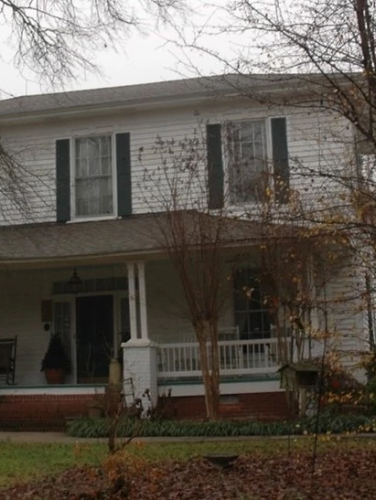
Thomas T. Sandifer House
(ca. 1850s)
The Thomas T. Sandifer House is one of the last standing antebellum farmhouses located on the Catawba River.
12601 Moores Chapel Rd, Charlotte, NC 28214
Located in the Paw Creek township, the Thomas T. Sandifer House is one of the few antebellum houses remaining in western Mecklenburg County. It is also one of the last farmhouses located on the Catawba River, along which many of the county’s important early farms were sited. The house and property were once part of a larger 246-acre tract purchased by Dr. Sandifer in the 1850s.
Property Quick Links
It is unknown when Thomas Thorn Sandifer (1818-1901), a native South Carolinian and physician by training, migrated to Mecklenburg County, but it is believed that he built the extant Sandifer House. By 1860, Dr. Sandifer held a considerable estate that included several tracts in the Paw Creek Township. He used the enslaved labor of at least three persons to maintain his agricultural operations. Throughout the 1870s and 1880s, Dr. Sandifer continued his medical practice while also farming and serving on the Mecklenburg County Board of Commissioners (first elected in 1878) and as a representative in the North Carolina General Assembly (beginning in 1883). His two marriages – first to Ann Matilda Wilson (1818-1864), then to the younger Elizabeth Susan Graham (1846-1930) – produced eleven children.
Dr. Sandifer accumulated such sizeable landholdings that when he died in 1901, his will prompted disputes among family members over the division of the land. In 1904, his widow Elizabeth sued the eighteen surviving family members. She ended up retaining eighty-nine acres of the original 246-acre farmstead, which included river frontage and probably the Sandifer House, while the eighteen children and grandchildren shared the remaining land. A special commission established to settle the dispute directed the children to sell their collective inheritance, resulting in the subdivision of the original farmstead.
Elizabeth Sandifer continued to own a large portion of the original farmstead until at least 1911, when she sold parcels to the Piedmont Traction Company, the predecessor company to the Piedmont and Northern Railway. As the Sandifer farm also laid in the path of development for the burgeoning textile industry, Elizabeth also sold land in 1912 to the Southern Power Company, now Duke Energy Corporation, as the company began providing electric power to local textile mills. It appears that John William Grice (1849-1927) subsequently purchased the remaining property. After Grice's death, his grandson Robert Auten bought a twenty-one-acre tract, including the Sandifer House, from the other fifty Grice heirs. A contractor by trade, Auten made many of the alterations to the house before selling it and fourteen acres in 1947 to his brother and sister-in-law Frank and Gladys Auten. The property has since changed hands several times.

